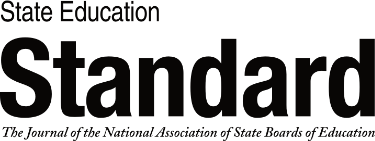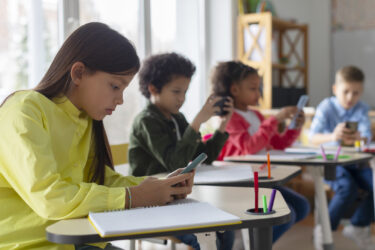Supporting Students with Disabilities in Transitioning to Adulthood
A collaborative approach can improve students’ outcomes.

Despite federal laws mandating services to support their postsecondary transitions, students with disabilities overall pursue less continued education and vocational training and get fewer jobs than their peers without disabilities. State boards of education can improve outcomes for these students by focusing on their transitions from K-12.
In 2023, 27.0 percent of youth with disabilities aged 16–19 participated in the labor force, compared with 37.5 percent of their same-age peers without disabilities (figure 1).[1] This disparity widens over time, with a nearly 45 percentage-point difference in employment rates for those aged 45–54. This persistent disparity underscores the urgent need for state boards to make transition services for students with disabilities more effective. By advocating for the use of evidence-based practices, fostering interagency collaboration, and identifying, implementing, and evaluating effective models of collaboration, state boards can play a pivotal role.

Education researchers typically focus more on how to support academic performance for students with disabilities than on postsecondary outcomes.[2] But K-12 students with disabilities are not prepared for life after high school to the degree that students without disabilities are.[3]
These disparities can be surmounted. In a correlational study, David W. Test and colleagues identified 23 practices/predictors that influence the success of students with disabilities in postsecondary education, employment, and independent living.[4] Each practice contains skills that, when taught explicitly to students with disabilities, improve their postsecondary outcomes in living, learning, and earning potential. Among them were career awareness, career and technical education, community experiences, interagency collaboration, self-determination, and work-based learning (WBL).[5]
In all of these areas, state board actions can improve postsecondary outcomes for students with disabilities and bridge the gaps between them and their nondisabled peers. Although there may be overlap in what predicts improved outcomes for all students, students with disabilities often need additional supports, services, and considerations to achieve similar outcomes as their peers without disabilities.
Career Development
Several predictors of success for students with disabilities revolve around setting goals, learning the skills to achieve those goals, and career development.[6] Self-determination and work readiness are examples of skills necessary to achieve their goals. Career exploration connects what students learn in class to the workforce and future careers. Career development encourages collaboration among students, families, schools, and communities.[7]
Several predictors of success for students with disabilities revolve around setting goals, learning the skills to achieve those goals, and career development.
Career development in schools can take many forms, including career awareness and WBL. Teachers can promote career awareness through culturally responsive, age-appropriate transition assessments and in curriculum while making explicit connections between academics, career skills, and WBL.[8]
WBL experiences are particularly important in equipping students with disabilities for adult life,[9] though they are important for their nondisabled peers as well. WBL provides “opportunities for individuals to gain hands-on, practical work experience through internships, apprenticeships, job shadowing, or other similar arrangements, which are designed to align with their career goals and provide them with the skills and knowledge needed for successful employment in a targeted occupation.”[10] These skills are particularly important because teachers identify lack of social and employment skills as one of the main barriers to postsecondary employment for students with disabilities.[11] However, academic intervention, school policies for participation, and teachers’ limited knowledge of how to teach these skills often hinder students with disabilities from participating in career development activities.[12]
Career development experiences should be provided in integrated community settings. They include, but are not limited to, job shadowing, career mentorship, informational interviews, paid or unpaid internships and other work experiences, workplace tours, service learning, and school-based enterprises. WBL experiences, offered in group or individual settings, are valuable for students in the early stages of exploring employment, and they help with the transition from school to the workforce. Through WBL, students can develop time management, organization, collaboration, and communication skills, which are crucial for finding, obtaining, performing in, retaining, and advancing in their jobs or careers.[13] Using explicit instruction in these work-ready activities cultivates self-determination and social skills students can apply at work and in life.[14]
Professional Development to Support Transition Planning
Successfully designed and implemented WBL requires collaboration among students, employers, educators, families, and community organizations. In this collaborative effort, all partners’ perspectives must be valued as they jointly form an individualized, culturally responsive plan informed by a student’s strengths, preferences, interests, and needs.[15]
An obstacle to such collaboration is special educators’ and transition coordinators’ frequent lack of preservice training and professional development in how to effectively implement WBL.[16] Initial special education teacher preparation includes seven standards in the areas of learner development and individual learning differences, learning environments, curricular content knowledge, assessment, instructional planning and strategies, professional learning and ethical practice, and collaboration.[17] As these standards demonstrate, special education teacher knowledge is both broad and deep. Additionally, over the last decade, the number of people entering teacher preparation programs has dropped by 30 percent. Coupled with low wages and high rates of teacher burnout and turnover, this decline in program participation has resulted in a national special education teacher shortage.[18]
Furthermore, approximately one-third of new teachers are not fully prepared to teach.[19] As a result, new teachers are not prepared to implement WBL; are not engaging, networking, and building relationships with employers; and often lack confidence in their ability to coordinate community opportunities for students.[20] Similarly, educators participating in a professional development study conducted by the Center for Advancing Policy on Employment for Youth reported the most difficulty finding and accessing training in the areas of interagency collaboration/partnerships and engaging with businesses.[21]
Interagency Collaboration
Under the federal Individuals with Disabilities Education Improvement Act (IDEA), schools must invite representatives from any agency responsible for providing or paying for transition services to students’ individualized education program meetings. Under the Workforce Innovation and Opportunity Act (WIOA) and the Rehabilitation Act, as amended, state vocational rehabilitation (VR) agencies must have a memorandum of understanding in place with state education agencies (SEAs) detailing the coordination of services for students with disabilities. As part of ensuring transition services are occurring for students with disabilities, schools must engage with service providers, including VR agencies, on the career development and WBL of these students.
Schools must engage with service providers, including VR agencies, on the career development and WBL of these students.
State boards should understand the components of the memorandum of understanding (MOU) with VR agencies as well as what these agencies can offer students with disabilities. For example, WIOA mandates that state VR agencies allocate at least 15 percent of their federal funding toward paying for or providing preemployment transition services to students with disabilities. Such services encompass job exploration, WBL, postsecondary education exploration, training in work readiness/employability skills, and instruction and practice in self-advocacy skills.[22] It is critical for state boards to inquire about how the MOU operates in their state, not only for understanding, but to ensure that SEAs are leveraging VR resources and supports to the maximum extent. By leveraging these resources and expertise, public schools can significantly enhance the opportunities for students with disabilities and help them achieve their vocational goals.
Collaboration supports students with disabilities by promoting better alignment of programs and services.[23] If they gain access to such collaborative services in high school, students with disabilities experience better outcomes after graduation.[24]
To strengthen interagency relationships during the students’ transition to adulthood, educators can develop a community resource map that displays available resources and supports, such as VR, American Job Centers, and centers for independent living. Such community mapping makes schools more aware of what is available and how students can access services and supports.[25] Community resource mapping can also pinpoint gaps that can inspire more robust career initiatives tailored to students with disabilities.
By fostering collaboration and establishing clear roles within a cross-functional team, educators and support networks can improve students’ transition planning and employment outcomes. A collective approach reduces service duplication, minimizes costs, and ultimately enriches the support students with disabilities receive.
State boards can play a vital role by supporting the building of structures and processes to enhance interagency collaboration, promote career development and WBL, and prioritize high-quality professional development for all educators. By fostering partnerships with relevant councils and agencies, state boards can create a collaborative environment where education officials, practitioners, and community partners align efforts and resources. State boards can also advocate for policies that prepare educators to effectively support students with disabilities in their transitions from school.
Recommendations for State Boards
Enhance Interagency Collaboration. State boards can implement practices to streamline communication and clarify roles and responsibilities for coordinated transition planning among partners. Over the years, districts have incrementally improved the coordination and delivery of transition services for students with disabilities, with pockets of excellence in some places. State leaders can do much to ensure that schools gain the time, resources, and skills to network with business partners and establish employer relationships that can yield robust, quality career development and work experiences for students with disabilities.[26] The MOU with the VR agency helps ensure that a broader team is supporting students with disabilities in receiving transition services and preparing for life after high school. It also reduces duplication of effort; provides students, families, and educators access to experts in employment services; and increases the community networks and opportunities available to students with disabilities.
State boards can implement practices to streamline communication and clarify roles and responsibilities for coordinated transition planning among partners.
Promote Work-Based Learning. By actively promoting WBL for students with disabilities, state boards will reaffirm their belief that all students can work and thrive. A proactive stance can enhance opportunities for students with disabilities, ensuring they gain foundational skills that will serve them well in their future careers. Recognizing the importance of WBL, 33 states have a statewide definition of WBL in policy, and 24 states allow high school students to earn credit for participation. Additionally, 38 states require or allow career exploration in middle school, ensuring early exposure to career pathways. To further support WBL, 28 states offer financial incentives, highlighting a commitment to expanding WBL opportunities for students.[27] Moreover, students in career and technical education (CTE) programs, where WBL is a requirement, have a graduation rate of 94 percent, surpassing the national average by 9 percentage points. Notably, CTE concentrators are equally likely to earn postsecondary degrees or certificates as their peers not in CTE.[28] These findings underscore the effectiveness of career-focused education in enhancing career development for all students, including those with disabilities.
Prioritize High-Quality Professional Development. Given the varied course sequences in preservice educational programs, state boards cannot assume novice teachers are learning how to effectively deliver transition services for students with disabilities. Alternative certification pathways to teaching only compound this challenge, as does the special education teacher shortage.[29] Without qualified teachers, schools must hire individuals without proper training and certifications. These challenges intensify the need for state boards to ensure that districts can offer high-quality professional development to bridge the gaps in expertise. Educators face barriers in accessing critical training that will equip them to incorporate culturally responsive, sustained transition practices to support the needs of diverse student populations.[30] State board members must ask how transition is being taught in preservice programs and advocate for more focus on career development for students with disabilities. Additionally, state boards can advocate for career development within school districts’ professional development plans.
Conclusion
Two decades since the enactment of IDEA, students with disabilities still lag behind their nondisabled peers in postsecondary education, vocational training, and employment.[31] To enhance outcomes for students with disabilities after they exit high school, state leaders must go beyond simply complying with federal mandates and promote transition services and plans adapted to students’ individual needs, preferences, and goals. These plans should emerge from ongoing collaboration among educators, students, families, and community partners, guaranteeing that each student has access to meaningful opportunities that align with their goals.
State leaders must go beyond simply complying with federal mandates and promote transition services and plans adapted to students’ individual needs, preferences, and goals.
Schools need to ensure students with disabilities benefit from evidence-based practices, including career development curricula and WBL. Through these initiatives, students with disabilities can cultivate work-readiness skills such as time management, organization, collaboration, and communication needed for adult life.
Additionally, fostering interagency collaboration can help schools harness resources to aid in the delivery of practices that are strongly correlated with postsecondary success. These collaborations offer students the possibilities of gaining real-world experiences that not only develop foundational career skills but also help them forge the community connections that lead to employment.
Community resource maps can help schools identify, define, and organize local resources that bolster WBL.[32] Although educators frequently lack the expertise and training for effective resource mapping and interagency collaboration, targeted professional development can help and should also address transition planning in general. Teachers and transition coordinators must be equipped with the latest research, strategies, and tools to navigate and support students throughout their transitions.
A comprehensive approach is key, combining collaborative partnerships, evidence-based practices, and strategic resource allocation. By investing in these efforts, state leaders, districts, and schools can empower and equip students with disabilities to build fulfilling, self-sufficient futures.
Jennifer K. Migliore, Jessica Ellott, Kimberly J. Osmani, and Lydia Dempsey are experts at Cornell University’s K. Lisa Yang and Hock E. Tan Institute on Employment and Disability, dedicated to advancing the inclusion and full participation of people with disabilities.
[1] US Bureau of Labor Statistics, “Labor Force Participation Rate 24.2 Percent for People with a Disability in 2023,” Economics Daily (October 1, 2024).
[2] Dawn A. Rowe et al., “A Delphi Study to Operationalize Evidence-Based Predictors in Secondary Transition,” Career Development and Transition for Exceptional Individuals 38, no. 2 (2015): 113–26, https://doi.org/10.1177/2165143414526429.
[3] Stephen M. Kwiatek et al., “Pivotal Legislation Supporting College and Career Readiness for Students with Disabilities,” Journal of Disability Policy Studies (2024), https://doi.org/10.1177/10442073241227820.
[4] David W. Test et al., “Evidence-Based Secondary Transition Predictors for Improving Postschool Outcomes for Students with Disabilities,” Career Development for Exceptional Individuals 32, no. 3 (2009): 160–81, https://doi.org/10.1177/0885728809346960.
[5] Predictors are categorized into levels of evidence: evidence-based, research-based, and promising practices. Valerie L Mazzotti et al., “Secondary Transition Predictors of Postschool Success: An Update to the Research Base,” Career Development and Transition for Exceptional Individuals 44, no. 1 (2021): 47–64, https://doi.org/10.1177/2165143420959793.
[6] Lauren Lindstrom et al., “Waging a Living: Career Development and Long-Term Employment Outcomes for Young Adults with Disabilities,” Exceptional Children 77, no. 4 (2011): 423–34, https://doi.org/10.1177/001440291107700403.
[7] Jessica Ellott et al., “Introducing Elementary Students to the World of Work,” Journal of Education 205, no. 1 (2025): 72–83, https://doi.org/10.1177/00220574241297991.
[8] Michael Stoehr et al., “Collaborative Assessment Guide for Transition Planning” (National Technical Assistance Center on Transition: the Collaborative, 2024); Rowe et al., “A Delphi Study.”
[9] Allison R. Lombardi et al., “An Intersectional Examination of College and Career Readiness for Youth with and without Disabilities,” Journal of Education (2024), https://doi.org/10.1177/00220574241309818.
[10] Workforce Innovation and Opportunity Act, Pub. L. No. 113–128 (2014).
[11] Erik W. Carter et al., “Preparing Youth for the World of Work: Educator Perspectives on Pre-Employment Transition Services,” Career Development and Transition for Exceptional Individuals 44, no. 3 (2021): 161–73, https://doi.org/10.1177/2165143420938663.
[12] Michele A. Schutz and Hilary A. Travers, “Career Development in Rural Districts: Opportunities and Limitations Regarding Students with Disabilities,” Rural Special Education Quarterly 42, no. 3 (2023): 136–51, https://doi.org/10.1177/87568705231179939.
[13] Elizabeth Devaney and Deborah Moroney, “Ready for Work? How Afterschool Programs Can Support Employability through Social and Emotional Learning,” Beyond the Bell (American Institutes for Research, 2015); Laura H. Lippman et al., “Workforce Connections: Key ‘Soft Skills’ That Foster Youth Workforce Success: Toward a Consensus across Fields,” no. 2015-24 (Child Trends, June 2015); V. Scott Solberg et al., “Promoting Quality Individualized Learning Plans: A ‘How to Guide’ Focused on the High School Years” (National Collaborative on Workforce and Disability for Youth, Institute for Educational Leadership, 2012).
[14] Ellott et al., “Introducing Elementary Students to the World of Work.”
[15] Rebekka J. Jez, “Culturally Responsive/Sustaining Transition for At-Promise Youth,” Career Development and Transition for Exceptional Individuals (March 20, 2024), https://doi.org/10.1177/21651434241235886; Geneva Gay, “Teaching to and through Cultural Diversity,” Curriculum Inquiry 43, no. 1 (2013): 48–70, https://doi.org/10.1111/curi.12002; Paula D. Kohler et al., “Taxonomy for Transition Programming 2.0: A Model for Planning, Organizing, and Evaluating Transition Education, Services, and Programs” (National Technical Assistance Center on Transition: The Collaborative, 2016); Charlotte Cahill, “Making Work-Based Learning Work,” paper (Jobs for the Future, 2016).
[16] Kaitlyn A. Jackson, “Educators’ Networks and Their Influence on Work-Based Learning for Transition-Aged Students with Intellectual and Developmental Disabilities: A Social Network Analysis,” thesis (University of Rochester, 2024); Debra T. Benitez et al., “A Multistate Survey of Special Education Teachers’ Perceptions of Their Transition Competencies,” Career Development for Exceptional Individuals 32, no. 1 (2009): 6–16, https://doi.org/10.1177/0885728808323945; Erik W. Carter et al., “Predictors of Postschool Employment Outcomes for Young Adults with Severe Disabilities,” Journal of Disability Policy Studies 23, no. 1 (2012): 50–63, https://doi.org/10.1177/1044207311414680.
[17] Council for Exceptional Children, ”Initial Special Education Preparation Standards,” web page.
[18] US Department of Education, “Teacher Shortage Areas,” web page.
[19] Linda Darling-Hammond, “Breaking the Legacy of Teacher Shortages,” article (Association for Supervision and Curriculum Development, October 1, 2022).
[20] Tim Riesen and Kathleen Marie Oertle, “Developing Work-Based Learning Experiences for Students with Intellectual and Developmental Disabilities: A Preliminary Study of Employers’ Perspectives,” The Journal of Rehabilitation 85, no. 2 (2019): 27–36; Benitez et al., “A Multistate Survey of Special Education Teachers’ Perceptions.”
[21] The educators included vocational rehabilitation counselors, K-12 educators, workforce systems, higher education, benefits planning specialists, juvenile justice, child welfare, and other youth service professionals. Kimberly J. Osmani et al., “Final Evaluation Report for the Professional Development Study” (Center for Advancing Policy on Employment for Youth, forthcoming).
[22] US Department of Education, Office of Special Education and Rehabilitative Services, “Coordinating Transition Services and Postsecondary Access: Guidance on Requirements under the IDEA and the Rehabilitation Act.”
[23] Kelli Crane and Marianne Mooney, “Essential Tools: Improving Secondary Education and Transition for Youth with Disabilities” (National Center on Secondary Education and Transition, University of Minnesota, 2005).
[24] Mazzotti et al., “Secondary Transition Predictors of Postschool Success”; Patricia M. Noonan et al., “Effects of Community Transition Teams on Interagency Collaboration for School and Adult Agency Staff,” Career Development and Transition for Exceptional Individuals 36, no. 2 (2013): 96–104, https://doi.org/10.1177/2165143412451119; Test et al., “Evidence-Based Secondary Transition Predictors.”
[25] Valerie L. Mazzotti and Dawn A. Rowe, Building Alliances: A How-To Manual to Support Transitioning Youth (Council for Exceptional Children, 2015).
[26] Dawn Anderson-Butcher et al., “A Case for Expanded School-Community Partnerships in Support of Positive Youth Development,” Children & Schools 28, no. 3 (2006): 155–63, https://doi.org/10.1093/cs/28.3.155.
[27] Education Commission of the States, ”Work-Based Learning: 50-State Comparison,” web page.
[28] ACTE, CTE Works fact sheet.
[29] US Department of Education, “Teacher Shortage Areas.”
[30] LaRon Scott et al., “Teacher Candidates’ Abilities to Develop Universal Design for Learning and Universal Design for Transition Lesson Plans,” International Journal of Inclusive Education 26, no. 4 (2022): 333–47, https://doi.org/10.1080/13603116.2019.1651910.
[31] Lombardi et al., “An Intersectional Examination of College and Career Readiness.”
[32] Mazzotti and Rowe, Building Alliances.
Also In this Issue
Sustaining Gains at the Pre-K to Kindergarten Transition
By Robert C. Pianta and Christina StephensBetter alignment in policy and practice can ensure that the skill boosts from pre-K persist throughout the elementary years.
Supporting Students in the Middle Grades
By Creed Dunn, Judy Frank and Allyson MorganAcademic success, engagement, attendance, and postsecondary preparation hinge on smooth transitions at the center of K-12.
Promoting Students’ Well-Being during the Transition to High School
By Briana A. López and Aprile D. BennerAcademic success in ninth grade requires supports for healthy social and emotional development.
Prioritizing the Measures of K-12 Success That Matter Most
By Ryan ReynaState leaders can drive real system improvements by rewarding K-12 schools for helping students succeed after high school.
FAFSA as a Pathway to Postsecondary Education
By Alessandra Cipriani-Detres, Anika Van Eaton and Elizabeth WoodLearning from early adopters of universal FAFSA can help other states design and implement effective policies.
How Illinois Gets Students Ready for College and Careers
By Emily RuscaState leaders build coherent policies and frameworks to help communities guide students through their postsecondary paces.
Supporting Students with Disabilities in Transitioning to Adulthood
By Jennifer K. Migliore, Jessica Ellott, Kimberly J. Osmani and Lydia DempseyA collaborative approach can improve students’ outcomes.









 i
i
 i
i
 i
i